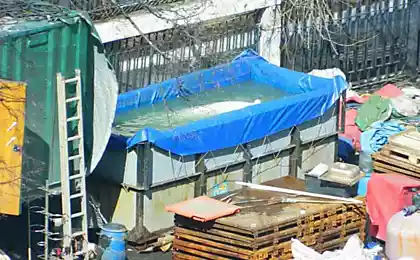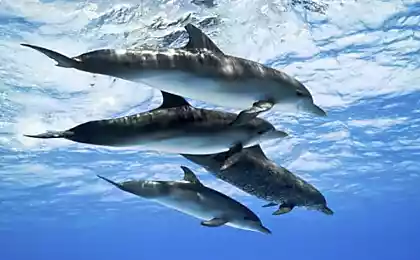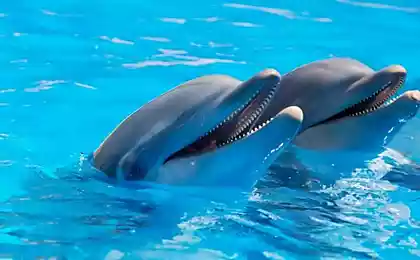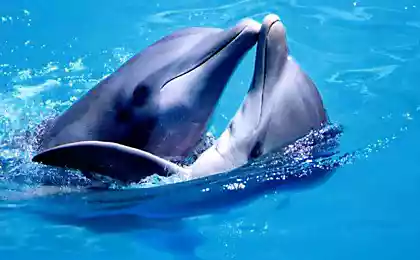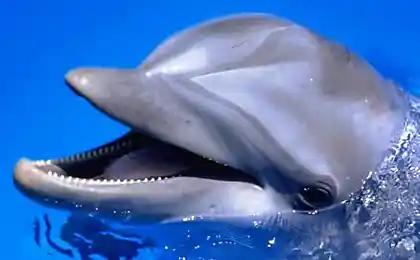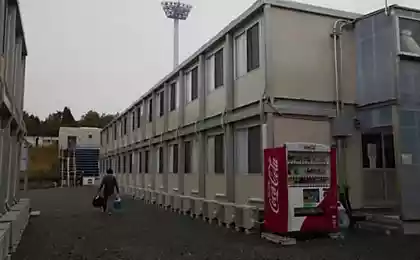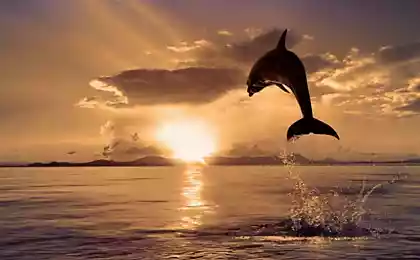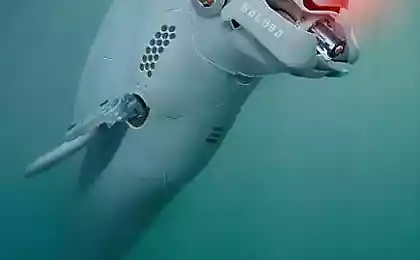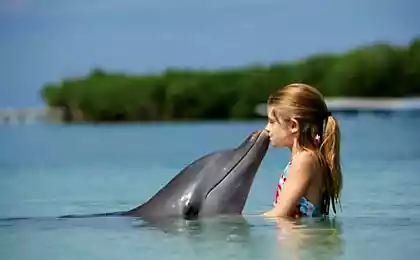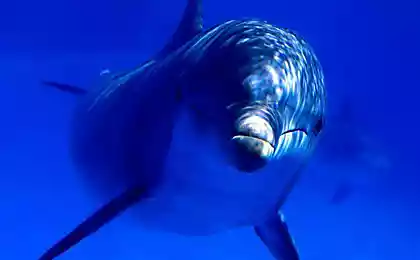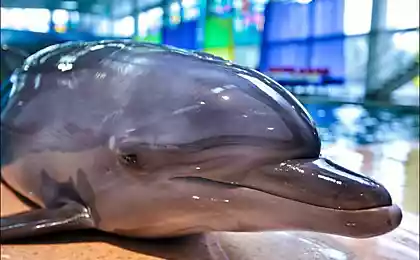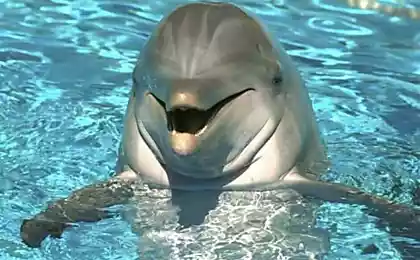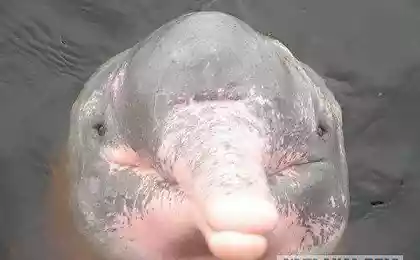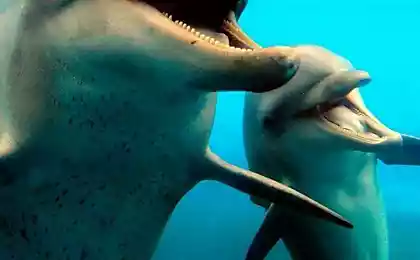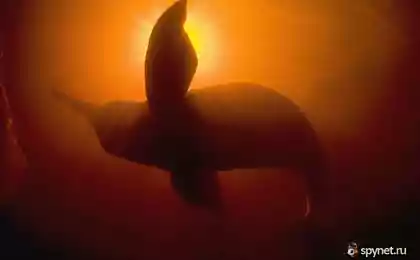643
SHOCK! Dolphinarium: on the other side of the holiday
RIC O Barry is a living legend. The man who did for the sake of the dolphins more than anyone on this planet. Rick and his organization the Dolphin Project are fighting for the freedom of dolphins for 46 years! He was one of the first coaches of the dolphins in the 1960-ies, when the dolphinariums industry is only beginning to emerge. For 10 years he was coach. During this time, saw the reality behind the scenes of the sea with your own eyes, but could not stay a part of this bloody business. He also trained dolphins and was understudy for the main character in the TV series "flipper" – the one with whom he began a boom industry of dolphinariums and shows featuring dolphins. Rick saw Katie, the female Dolphin, which in most series played flipper, committed suicide. He says she looked him in the eye, dived to the bottom of the pool and stopped breathing. This moment for the rest of my life turned Dolphin trainer in activist animal rights activist.
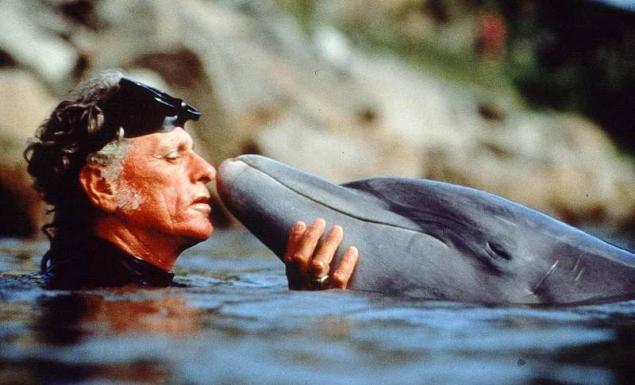
Fame brought O Barry's role in the documentary "the Cove". The film received an Academy award and tells of the trade in Dolphin meat in Taiji, one of the cities of Japan. Rick O Barry: "Recently, my colleague mark Palmer wrote about the death of Us, 28-year-old dolphins-orcas. We often saw her in the Museum of whaling in Taiji, until the animal was moved to the Nagoya aquarium last year. A month ago We in this aquarium died, the deaths of killer whales in captivity eerily frequent. Conclusion: it doesn't matter, do they call the cause of death of stones and rocks in the whaling Museum, peptic ulcer or pneumonia – direct cause of death, We have the conditions of life in captivity. In natural conditions the Dolphin, the killer whale lives at least twice as long". Rick O Barry has led the campaign against mobile circuses of Indonesia, created a project Dolphin Project, which has for many years supported the struggle against dolphinariums, traveling circuses, and in the first place – against the cruel catch of dolphins in Japan. Every year from September to March, in the infamous Cove of Taiji, catch suitable and beautiful dolphins for sale to dolphinariums and not beautiful enough to kill for meat. The Dolphin Project team is in Taiji throughout the hunting season for dolphins, documenting events and distributing information. All actions of the team are made in strict obedience of the Japanese laws. 18 January 2016 Rick O Barry was detained at Narita airport in Tokyo. 76-year-old animal rights activist was repeatedly interrogated and placed in the deportation room is a prison. After 19 days in captivity, he was put on a plane by the Japanese authorities. Presented the Japanese government has long sought to deport Barry O, and ultimately the reason for the deportation was the fact that allegedly Rick for not giving them the full truthful information during an interrogation last year. Sounds ridiculous, isn't it?! For the Japanese state Rick O Barry for 14 years a huge pain. Over 14 years of work on the issue of the killing of dolphins in Japan Rick has achieved great success. Exactly thank him out the documentary "the Cove", and the world learned about the terrible secret of a small Japanese town. 19 days 76-year-old hero Rick O Barry lost 10 kg and was in the hospital with a bout of chest pain. "It's very ironic that trying to do so to shut me up, they draw more attention to the film "the Bay". The fact that I was deported from the country, whom I liked so much, just breaks my heart." – Rick O Barry. According to Rick deportation is not the end but the beginning of something new. After the release in 2009 Oscar-winning documentary "the Cove" about the killing and capture of dolphins in Taiji town, Wakayama Prefecture, Rick O Barry was subjected to constant interrogation at the entrance to Japan. "I will never go back home on their own, and try to do everything possible to let me in to Japan. I am not an enemy of the Japanese people," said Rick O Barry in conversation with the lawyer. Many celebrities, including Harry styles, Maisie Williams, Yoko Ono, Ben Stiller, Matt Sorum and sting stand with Rick O ' Barry in his work. Moreover, everyone in the Japanese town of Taiji, knows who Rick is. Thanks to the efforts of this heroic man, the world learned of the bloody secret of Japan. Japanese authorities more than a year looking for reasons to detain Rica, and they succeeded! A little information about the problem
Who is killing the dolphins? The catching of dolphins in the small fishing village of Taiji, approximately 26-th fishermen. They kill dolphins with the permission from their government. Approximately a couple dozen people helping in murder on the shore, butchering dolphins, and distribution of meat. Most people in the town of Taiji have nothing to do with hunting dolphins. Most people in Japan do not know about the annual massacre of dolphins that are allowed by the state. The killing of dolphins is permitted by the state, and that means legally in Japan. How they kill the dolphins? The fishermen drive the dolphins into shallow water close to the rocky shore.At a time when were shooting the documentary film "the Cove", the fishermen kill the dolphins long, sharp spears. Most often they stabbed the fishing hooks were still alive dolphins and dragged them to their boats. It was a monstrous cruelty. The dolphins struggled and splashed in his own blood, and the air was filled with their cries. This carnage filled waters of the Bay red with blood. After the release of the film "the Bay" fishermen have changed the method of killing. Now they drag the dolphins under a massive plastic sheds (set to prevent the capture of the murder). There, the fishermen killer drive sharp metal pin into the neck of the Dolphin, just behind the blowhole, which presumably cuts the spinal cord, which should lead to instant "humane" death. Then the murderers plug the wound stereobase wooden bung, so that the blood is not flooded Bay – this is done to ensure that we could not film the bloody Bay. There are videos from hidden cameras that show the dolphins splashing and struggling for several agonizing minutes. Why are they killing the dolphins? Officially, the main reason for hunting dolphins is supply Dolphin meat to the people of Japan – but, in fact, only a small minority of people in Japan eat Dolphin meat. We have the impression that Dolphin meat is considered "garbage", as opposed to the more expensive whale meat. DNA tests conducted on the meat under the title “whale meat” in Japanese markets have revealed that this meat is, in fact, falsely labeled Dolphin meat. Whale meat is sold much more expensive than the meat of dolphins – so cheating Japanese buyers who purchase Dolphin meat, which is sold under the guise of whale meat. There is another important and quite shocking aspect of the Dolphin hunt: during a meeting with the Taiji fishermen in January 2004, the fishermen told us that they hunt dolphins for meat and sale for industry of dolphinariums, and that hunting is also "a form of pest control". From the point of view of fishermen, dolphins eat too many fish and the fishermen are simply killing the competition. This is the first time when the Japanese Dolphin hunters have openly admitted that they control the "pests dolphins." Overfishing of the oceans is a huge global problem, and the Japanese fishermen, supported by their government, wrongly accused of dolphins in it. The Japanese government say the same about the argument of the International whaling Commission – that whales eat fish and therefore must be brought under control by murder. The desire to keep the population of dolphins is low – the main reason why the Japanese government is committed to issue permits for the hunt. In fact, it is not to provide meat for Japanese people, and not for conservation that the fishermen repeatedly call them “tradition” or “culture”. We are talking about the elimination of as many dolphins, to fish the oceans were available for them. We know about some of the places in Japan where local Dolphin populations have declined or been destroyed this logic, fully supported by the government of Japan. In addition, the powerful Japanese fisheries Agency promotes the killing of dolphins and whales as part of Japan's "traditional food", despite the fact that a small number of Japanese people are interested in eating the meat of whales and dolphins now. This is evidenced by the huge surplus of meat stored in cold storage. What types of dolphins and how they kill? This year the Japanese fisheries Agency gave permission to the fishermen to kill or catch nearly 16,000 cetaceans. At that moment, when the movie "the Cove" the number of permits exceeded 23 000. Nearly 2,000 dolphins were killed in Taiji, by the so-called "hunting pen". The rest are killed with hand harpoons used from small boats in the sea along the coast of Japan, especially in Northern ports. While the quota for driven hunting is reduced and fewer dolphins are killed, the number captured dolphins for the entertainment industry is gradually increasing.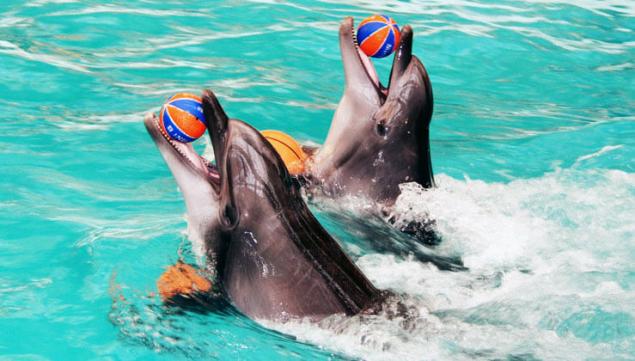
Dolphin species included in the quota for the murder: • Bottlenose Dolphin• Risso's Dolphins, (Dolphin Grey) • False killer whales• Pacific Whiteside dolphins• Whales• Petrovicescu spotted dolphins• Striped dolphins As the Japanese catch dolphins? The hunters of Taiji have developed a very efficient method of search, capture and destruction of dolphins, sometimes more than 100 in one day. Before dawn, about 26 hunters loaded on Board his 13 boats and swim in the deep water where the dolphins migrate. The dolphins are using these migratory paths for thousands, and possibly millions of years, and so the hunters know exactly where to find them. When a school of dolphins swims by, the hunters are building their boats evenly for each other. Then they are dipped in water the steel poles on each boat, one on each side. Hunters start hammering on that steel poles that start to ring like a bell under water, amplifying the sound. This noise creates a wall of sound under water and the dolphins suddenly find themselves trapped, wedged between the sound wall and coastline. In an attempt to escape from the sound, the dolphins swim in the opposite direction to the shore. Panic-stricken, they lose orientation in space, and the hunters manage to drive them in a small hidden Cove at Taiji harbour. The hunters block the entrance to the Bay nets, dolphins are trapped, with no way out. We present you a short interview with the Dolphin defender RIC O Barry.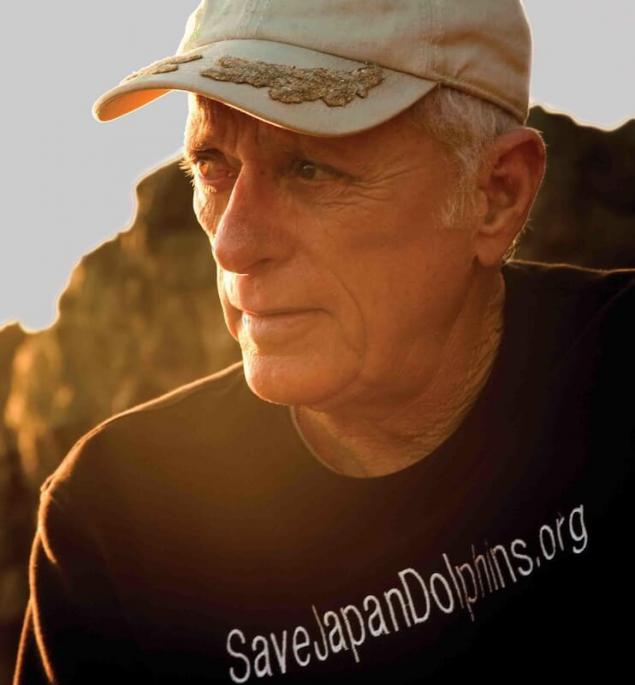
1. How did You become a Dolphin trainer? During his service in the Navy, I visited the aquarium in Miami to see the show. I wanted to be a guy who feeds dolphins in the main pool. When I retired, did so and found a job at the aquarium. Gradually began to exercise, working with captive dolphins and experienced trainers. 2. How You became involved in the movie "flipper"? Producer Ivan Tors made the film "flipper" with Chuck Connors in the title role. The film was a success, so subsequently it was decided to make the eponymous television series. I was hired to catch the five dolphins that played the role of flipper in the TV series, and train them. 3. What made You change your opinion about the captivity of dolphins in captivity? I knew long ago that dolphins cannot live in captivity. After filming the TV series "flipper" dolphins who participated in the film, was sent into the basins of the Miami Seaquarium. One of them, Katie, died in the pool right in my hands. She just stopped breathing – in fact, she committed suicide. Katie was very special to me Dolphin. The next day I went to jail Bimini for trying to release a Dolphin that had been in captivity. I stopped to train dolphins and later became an advocate against their captivity. 4. As Your Hollywood connections helped You in the movie "the Cove"? In fact, does. The film "the Cove" was created by Director Louie Psihoyos from the Society for the preservation of flora and fauna of the ocean. It was the first film Louis. And he did it all himself. This film was not "filmed" me is a movie about me and my work. However, the film "the Cove" evoked great interest among the Hollywood celebrities. He became a "basis" for our series about the killing of dolphins on the channel animal planet. Thus, the film "the Cove" is really very much help, telling the world about the mass killings of dolphins and the problems captivity of dolphins in captivity. 5. In Your opinion, what all people must know about dolphins? The fact that dolphins are very special animals. They are self-aware, that is they are aware of themselves as separate species that can only people, great apes and elephants. Their "smile" is deceptive, as they can't control their facial expressions, like us. They belong in the wild and can't be kept in captivity. 6. Represent the dolphins in aquariums is very popular. If the dolphins are not kept in captivity, as people would be able to know and take care of them? There are many opportunities, in my opinion. People can work in environmental organisations around the world to see dolphins and whales in the ocean, in their natural habitat. There are many wonderful documentaries about whales and dolphins. The Monterey Bay Aquarium, in California, on display plastic models of whales at life-size. And there are companies engaged in the manufacture dolphins, robots that could replace live dolphins to aquariums. I'd like to add that the submission in aquariums almost nothing to tell people about how these animals behave in their natural environment. It's just a circus show demonstrating human superiority over the dolphins, not educational information. These stupid submission, actually, are anti-educational. 7. Why people should be interested in the plight of dolphins in Japan? The killing of dolphins in Japan – is the worst thing that can happen with all animals on the planet. Especially for animals that are intelligent enough to realize this. The Japanese government annually issues 23,000 permits the killing of dolphins in the coastal areas, which is the mass slaughter of dolphins. This issue also concerns human rights, as Japanese consumers eating contaminated meat that contains mercury. The government is making great efforts to hide it. I believe that humanity should be interested in the position of the whales and dolphins because many of our environmental problems associated with them is the pollution of water and air, destruction of natural habitat, the brutal murder, the future of our oceans, etc. 8. What do You think about the attitude of Hollywood to animals artists? As You consider whether the laws against them? It very much depends on the type of animal. Hollywood is engaged in social activities, so most tends to draw attention (in contrast to slaughterhouses, for example). In addition, there is a trend to use animals-robots instead of living animals, which, in my opinion, just wonderful. In the first film "Free Willy" was used alive orca named Keiko, however, all subsequent films were made using a mechanical whale. The company "Warner brothers", in the end, helped to raise funds for the rehabilitation and release of Keiko, who was released in Iceland. 9. What can people do to stop what is happening in the Bay murders? People can do very much. We encourage everyone to visit our website www.SaveJapanDolphins.org as well as our website about the issues of dolphins in Japan www.DolphinProject.org. The website contains an online petition which you can sign up. In our blogs we share the latest information about what I do and our team project to rescue the dolphins. And we also accept alarms from people and take appropriate action. We urge people not to buy tickets to dolphinariums. This is the best way to close view of dolphins in captivity. People can also help us as volunteers or by making donations. Tell this to anyone! If other people find out about "the Cove" about the mass murder of dolphins in Japan, we will be able to attract someone else, to our campaign. Our strength is in numbers.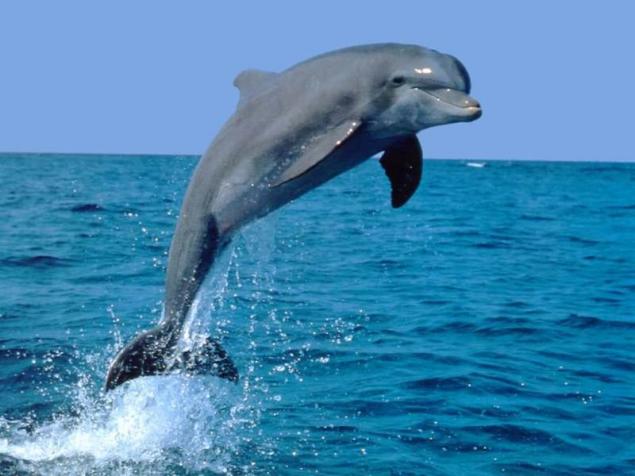
10. What do You consider your greatest achievement as a fighter for the liberation of dolphins? In my opinion, it is publicity about the problems. Whether we are talking about the problems of maintenance of dolphins in captivity, about the hunt for dolphins in Taiji or my participation in the film "the Cove", I was able to tell people about how dolphins and whales are killed and exploited. Very few people realize how the situation really is. But when they find out, they will want to help. So my job is to draw public attention to these issues. We managed to close or suspend the construction of many dolphinariums, and also to stop the submission of dolphins in captivity around the world. In addition, we're making progress in trying to stop the hunting of dolphins in Japan, overcoming the conspiracy of silence that is stored by the Japanese government and the media. We have a long way to go, but we will prevail – it will just take time. published
http://cdn00.vidyomani.com/c/2/4/1/eb90chm5prds/index.html
Also read: Shocking photo: the Production of fur in China
Over the past 45 years, the population of the world's oceans has halved
P. S. And remember, only by changing their consumption — together we change the world! ©
Source: www.oum.ru/literature/raznoe/delfiny/

Fame brought O Barry's role in the documentary "the Cove". The film received an Academy award and tells of the trade in Dolphin meat in Taiji, one of the cities of Japan. Rick O Barry: "Recently, my colleague mark Palmer wrote about the death of Us, 28-year-old dolphins-orcas. We often saw her in the Museum of whaling in Taiji, until the animal was moved to the Nagoya aquarium last year. A month ago We in this aquarium died, the deaths of killer whales in captivity eerily frequent. Conclusion: it doesn't matter, do they call the cause of death of stones and rocks in the whaling Museum, peptic ulcer or pneumonia – direct cause of death, We have the conditions of life in captivity. In natural conditions the Dolphin, the killer whale lives at least twice as long". Rick O Barry has led the campaign against mobile circuses of Indonesia, created a project Dolphin Project, which has for many years supported the struggle against dolphinariums, traveling circuses, and in the first place – against the cruel catch of dolphins in Japan. Every year from September to March, in the infamous Cove of Taiji, catch suitable and beautiful dolphins for sale to dolphinariums and not beautiful enough to kill for meat. The Dolphin Project team is in Taiji throughout the hunting season for dolphins, documenting events and distributing information. All actions of the team are made in strict obedience of the Japanese laws. 18 January 2016 Rick O Barry was detained at Narita airport in Tokyo. 76-year-old animal rights activist was repeatedly interrogated and placed in the deportation room is a prison. After 19 days in captivity, he was put on a plane by the Japanese authorities. Presented the Japanese government has long sought to deport Barry O, and ultimately the reason for the deportation was the fact that allegedly Rick for not giving them the full truthful information during an interrogation last year. Sounds ridiculous, isn't it?! For the Japanese state Rick O Barry for 14 years a huge pain. Over 14 years of work on the issue of the killing of dolphins in Japan Rick has achieved great success. Exactly thank him out the documentary "the Cove", and the world learned about the terrible secret of a small Japanese town. 19 days 76-year-old hero Rick O Barry lost 10 kg and was in the hospital with a bout of chest pain. "It's very ironic that trying to do so to shut me up, they draw more attention to the film "the Bay". The fact that I was deported from the country, whom I liked so much, just breaks my heart." – Rick O Barry. According to Rick deportation is not the end but the beginning of something new. After the release in 2009 Oscar-winning documentary "the Cove" about the killing and capture of dolphins in Taiji town, Wakayama Prefecture, Rick O Barry was subjected to constant interrogation at the entrance to Japan. "I will never go back home on their own, and try to do everything possible to let me in to Japan. I am not an enemy of the Japanese people," said Rick O Barry in conversation with the lawyer. Many celebrities, including Harry styles, Maisie Williams, Yoko Ono, Ben Stiller, Matt Sorum and sting stand with Rick O ' Barry in his work. Moreover, everyone in the Japanese town of Taiji, knows who Rick is. Thanks to the efforts of this heroic man, the world learned of the bloody secret of Japan. Japanese authorities more than a year looking for reasons to detain Rica, and they succeeded! A little information about the problem
Who is killing the dolphins? The catching of dolphins in the small fishing village of Taiji, approximately 26-th fishermen. They kill dolphins with the permission from their government. Approximately a couple dozen people helping in murder on the shore, butchering dolphins, and distribution of meat. Most people in the town of Taiji have nothing to do with hunting dolphins. Most people in Japan do not know about the annual massacre of dolphins that are allowed by the state. The killing of dolphins is permitted by the state, and that means legally in Japan. How they kill the dolphins? The fishermen drive the dolphins into shallow water close to the rocky shore.At a time when were shooting the documentary film "the Cove", the fishermen kill the dolphins long, sharp spears. Most often they stabbed the fishing hooks were still alive dolphins and dragged them to their boats. It was a monstrous cruelty. The dolphins struggled and splashed in his own blood, and the air was filled with their cries. This carnage filled waters of the Bay red with blood. After the release of the film "the Bay" fishermen have changed the method of killing. Now they drag the dolphins under a massive plastic sheds (set to prevent the capture of the murder). There, the fishermen killer drive sharp metal pin into the neck of the Dolphin, just behind the blowhole, which presumably cuts the spinal cord, which should lead to instant "humane" death. Then the murderers plug the wound stereobase wooden bung, so that the blood is not flooded Bay – this is done to ensure that we could not film the bloody Bay. There are videos from hidden cameras that show the dolphins splashing and struggling for several agonizing minutes. Why are they killing the dolphins? Officially, the main reason for hunting dolphins is supply Dolphin meat to the people of Japan – but, in fact, only a small minority of people in Japan eat Dolphin meat. We have the impression that Dolphin meat is considered "garbage", as opposed to the more expensive whale meat. DNA tests conducted on the meat under the title “whale meat” in Japanese markets have revealed that this meat is, in fact, falsely labeled Dolphin meat. Whale meat is sold much more expensive than the meat of dolphins – so cheating Japanese buyers who purchase Dolphin meat, which is sold under the guise of whale meat. There is another important and quite shocking aspect of the Dolphin hunt: during a meeting with the Taiji fishermen in January 2004, the fishermen told us that they hunt dolphins for meat and sale for industry of dolphinariums, and that hunting is also "a form of pest control". From the point of view of fishermen, dolphins eat too many fish and the fishermen are simply killing the competition. This is the first time when the Japanese Dolphin hunters have openly admitted that they control the "pests dolphins." Overfishing of the oceans is a huge global problem, and the Japanese fishermen, supported by their government, wrongly accused of dolphins in it. The Japanese government say the same about the argument of the International whaling Commission – that whales eat fish and therefore must be brought under control by murder. The desire to keep the population of dolphins is low – the main reason why the Japanese government is committed to issue permits for the hunt. In fact, it is not to provide meat for Japanese people, and not for conservation that the fishermen repeatedly call them “tradition” or “culture”. We are talking about the elimination of as many dolphins, to fish the oceans were available for them. We know about some of the places in Japan where local Dolphin populations have declined or been destroyed this logic, fully supported by the government of Japan. In addition, the powerful Japanese fisheries Agency promotes the killing of dolphins and whales as part of Japan's "traditional food", despite the fact that a small number of Japanese people are interested in eating the meat of whales and dolphins now. This is evidenced by the huge surplus of meat stored in cold storage. What types of dolphins and how they kill? This year the Japanese fisheries Agency gave permission to the fishermen to kill or catch nearly 16,000 cetaceans. At that moment, when the movie "the Cove" the number of permits exceeded 23 000. Nearly 2,000 dolphins were killed in Taiji, by the so-called "hunting pen". The rest are killed with hand harpoons used from small boats in the sea along the coast of Japan, especially in Northern ports. While the quota for driven hunting is reduced and fewer dolphins are killed, the number captured dolphins for the entertainment industry is gradually increasing.

Dolphin species included in the quota for the murder: • Bottlenose Dolphin• Risso's Dolphins, (Dolphin Grey) • False killer whales• Pacific Whiteside dolphins• Whales• Petrovicescu spotted dolphins• Striped dolphins As the Japanese catch dolphins? The hunters of Taiji have developed a very efficient method of search, capture and destruction of dolphins, sometimes more than 100 in one day. Before dawn, about 26 hunters loaded on Board his 13 boats and swim in the deep water where the dolphins migrate. The dolphins are using these migratory paths for thousands, and possibly millions of years, and so the hunters know exactly where to find them. When a school of dolphins swims by, the hunters are building their boats evenly for each other. Then they are dipped in water the steel poles on each boat, one on each side. Hunters start hammering on that steel poles that start to ring like a bell under water, amplifying the sound. This noise creates a wall of sound under water and the dolphins suddenly find themselves trapped, wedged between the sound wall and coastline. In an attempt to escape from the sound, the dolphins swim in the opposite direction to the shore. Panic-stricken, they lose orientation in space, and the hunters manage to drive them in a small hidden Cove at Taiji harbour. The hunters block the entrance to the Bay nets, dolphins are trapped, with no way out. We present you a short interview with the Dolphin defender RIC O Barry.

1. How did You become a Dolphin trainer? During his service in the Navy, I visited the aquarium in Miami to see the show. I wanted to be a guy who feeds dolphins in the main pool. When I retired, did so and found a job at the aquarium. Gradually began to exercise, working with captive dolphins and experienced trainers. 2. How You became involved in the movie "flipper"? Producer Ivan Tors made the film "flipper" with Chuck Connors in the title role. The film was a success, so subsequently it was decided to make the eponymous television series. I was hired to catch the five dolphins that played the role of flipper in the TV series, and train them. 3. What made You change your opinion about the captivity of dolphins in captivity? I knew long ago that dolphins cannot live in captivity. After filming the TV series "flipper" dolphins who participated in the film, was sent into the basins of the Miami Seaquarium. One of them, Katie, died in the pool right in my hands. She just stopped breathing – in fact, she committed suicide. Katie was very special to me Dolphin. The next day I went to jail Bimini for trying to release a Dolphin that had been in captivity. I stopped to train dolphins and later became an advocate against their captivity. 4. As Your Hollywood connections helped You in the movie "the Cove"? In fact, does. The film "the Cove" was created by Director Louie Psihoyos from the Society for the preservation of flora and fauna of the ocean. It was the first film Louis. And he did it all himself. This film was not "filmed" me is a movie about me and my work. However, the film "the Cove" evoked great interest among the Hollywood celebrities. He became a "basis" for our series about the killing of dolphins on the channel animal planet. Thus, the film "the Cove" is really very much help, telling the world about the mass killings of dolphins and the problems captivity of dolphins in captivity. 5. In Your opinion, what all people must know about dolphins? The fact that dolphins are very special animals. They are self-aware, that is they are aware of themselves as separate species that can only people, great apes and elephants. Their "smile" is deceptive, as they can't control their facial expressions, like us. They belong in the wild and can't be kept in captivity. 6. Represent the dolphins in aquariums is very popular. If the dolphins are not kept in captivity, as people would be able to know and take care of them? There are many opportunities, in my opinion. People can work in environmental organisations around the world to see dolphins and whales in the ocean, in their natural habitat. There are many wonderful documentaries about whales and dolphins. The Monterey Bay Aquarium, in California, on display plastic models of whales at life-size. And there are companies engaged in the manufacture dolphins, robots that could replace live dolphins to aquariums. I'd like to add that the submission in aquariums almost nothing to tell people about how these animals behave in their natural environment. It's just a circus show demonstrating human superiority over the dolphins, not educational information. These stupid submission, actually, are anti-educational. 7. Why people should be interested in the plight of dolphins in Japan? The killing of dolphins in Japan – is the worst thing that can happen with all animals on the planet. Especially for animals that are intelligent enough to realize this. The Japanese government annually issues 23,000 permits the killing of dolphins in the coastal areas, which is the mass slaughter of dolphins. This issue also concerns human rights, as Japanese consumers eating contaminated meat that contains mercury. The government is making great efforts to hide it. I believe that humanity should be interested in the position of the whales and dolphins because many of our environmental problems associated with them is the pollution of water and air, destruction of natural habitat, the brutal murder, the future of our oceans, etc. 8. What do You think about the attitude of Hollywood to animals artists? As You consider whether the laws against them? It very much depends on the type of animal. Hollywood is engaged in social activities, so most tends to draw attention (in contrast to slaughterhouses, for example). In addition, there is a trend to use animals-robots instead of living animals, which, in my opinion, just wonderful. In the first film "Free Willy" was used alive orca named Keiko, however, all subsequent films were made using a mechanical whale. The company "Warner brothers", in the end, helped to raise funds for the rehabilitation and release of Keiko, who was released in Iceland. 9. What can people do to stop what is happening in the Bay murders? People can do very much. We encourage everyone to visit our website www.SaveJapanDolphins.org as well as our website about the issues of dolphins in Japan www.DolphinProject.org. The website contains an online petition which you can sign up. In our blogs we share the latest information about what I do and our team project to rescue the dolphins. And we also accept alarms from people and take appropriate action. We urge people not to buy tickets to dolphinariums. This is the best way to close view of dolphins in captivity. People can also help us as volunteers or by making donations. Tell this to anyone! If other people find out about "the Cove" about the mass murder of dolphins in Japan, we will be able to attract someone else, to our campaign. Our strength is in numbers.

10. What do You consider your greatest achievement as a fighter for the liberation of dolphins? In my opinion, it is publicity about the problems. Whether we are talking about the problems of maintenance of dolphins in captivity, about the hunt for dolphins in Taiji or my participation in the film "the Cove", I was able to tell people about how dolphins and whales are killed and exploited. Very few people realize how the situation really is. But when they find out, they will want to help. So my job is to draw public attention to these issues. We managed to close or suspend the construction of many dolphinariums, and also to stop the submission of dolphins in captivity around the world. In addition, we're making progress in trying to stop the hunting of dolphins in Japan, overcoming the conspiracy of silence that is stored by the Japanese government and the media. We have a long way to go, but we will prevail – it will just take time. published
http://cdn00.vidyomani.com/c/2/4/1/eb90chm5prds/index.html
Also read: Shocking photo: the Production of fur in China
Over the past 45 years, the population of the world's oceans has halved
P. S. And remember, only by changing their consumption — together we change the world! ©
Source: www.oum.ru/literature/raznoe/delfiny/
Shocking counter-advertising about the dangers of sweets. When the words are powerless
Proven ways to use sawdust in the country



